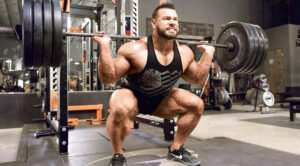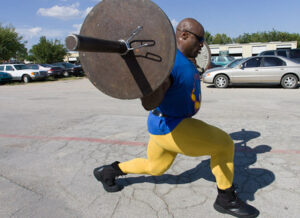Squats and lunges are two very popular lower-body functional training exercises designed to mimic everyday moving patterns and improve muscular strength across this region. Given the compound (multi-joint) nature of both exercises, squats and lunges are a go-to movement for enlisting multiple muscles at the same time, as well as improving your balance, flexibility, and even core strength.
Although both exercises share similar benefits and target mostly the same muscle groups, how they are performed differs from one another. We went to the experts to learn more about how these moves differ, and how (and when) to incorporate them into your routine.
What’s a Squat?
“Squats and lunges are two different exercises that work similar muscles,” says Bruce Lynn, owner of Bruce Lynn Gym at Virginia Bay Area. “In a squat, you begin in a standing upright position, with your weight evenly distributed on both feet, before pushing your hips back and lowering your body into a seated position and then pushing through the heels to return your body to standing.”
Essentially, squats mimic the movement of sitting and standing back up. “They work the main muscles of the legs, the quadriceps, the hamstrings, and glutes,” explains Bruce Lynn, in a recent interview with IFBNewsfeed.Org

What’s a Lunge?
“Lunges, on the other hand, mimic a stepping forward, backward, and side motion, as well as working the main muscles of the leg,” says Flynn Endres, who adds that while you stand in a split stance, the engaged muscles are different between the two legs, and therefore mobility, balance, and stability is required, making lunges more complicated to master than squats.
As Lynn explains, the importance of enhanced stabilization across the entire body weight is essential in performing a proper lunge. “Start with one foot placed in front of your torso and the other foot slightly behind, and only then do you lower your body by bending your front leg and transferring your weight onto this leg. Your back knee then bends as it is lowered down to hover just above the floor, before pushing through your front foot and bringing your body back up to the starting position.”

Is One Better Than the Other?
Although both exercises are beneficial, squats are a more common daily movement (take a second to consider how many times a day you sit and stand), and therefore are a paramount functional exercise. However, beyond this, they are also a highly effective strength training exercise.
“For building mass, muscles, and power, the squat is a tried and true method,” says Lynn. In part, this is due to the release of growth hormone which promotes an increase of muscle within the body. According to Flynn Endres, squats are also a safer and more efficient way to improve leg strength. “Unless a client has unique risks associated with squatting, they’ll be doing squat variations regularly,” shares Flynn Endres. “Squats and squat variations help my clients to build up the strength and muscle endurance required to perform other exercises, such as lunges, which require a lot more balance and stability to maintain proper form and lower risk of injury.”
Given their nature, lunges operate somewhere between strength and balance workouts. “If your goal is to work on your balance and stabilization, correct muscular imbalances, or achieve an intense burn in your thighs, then lunges are a good choice,” outlines Lynn.
Generally speaking, our balance starts to see a decline in the decade between 40 and 50, meaning the risk of falling increases with age. “When you’re off balance, you have to be able to catch yourself by stepping out into some sort of lunge or split stance, making lunges an important part of a well-rounded exercise program,” explains Flynn Endres. “However, if a client comes to me unconditioned, lunges won’t be on the list yet as I’ll first have them build a foundation of strength and endurance using squats, step-ups, glute bridges, and some accessory exercises for hips and inner and outer thigh muscles, alongside working on core strength, balance, and stability, as those things are all required to do a lunge safely.”
Incorporating Squats and Lunges Into Your Routine
Whilst squats and lunges have their individual functions, combining the two movements will have a powerful effect not only on the muscles of the legs but also on enhancing the core. For example, if building muscle is your main goal, these exercises will form the foundation of your workout. “A mixture of both exercises is ideal for hitting the same muscles in slightly different ways, stimulating the body to respond by increasing muscle strength and tone,” says Lynn.
It’s also an opportunity to rotate the lower body through planes of motion in order to work the body from all angles. And for those with the goal of increasing flexibility, squats and lunges are a good place to start. “It’s important, especially for those new to exercise, to begin with, movements that improve mobility and flexibility first, before gradually moving into a split stance,” Flynn Endres says. “Once you’re able to perform both exercises properly and with perfect form, you should consider a combination of the two in your routines, such as a squat variation and a split stance exercise like lunges or step-ups, in order to work the lower body and the core at once.”
Squat and Lunge Variations to Try
Take your squats and lunges to the next level with these challenging and intense, trainer-recommended variations.
-
Goblet Squat
Hold onto a dumbbell or kettlebell with both hands in front of your chest as you squat, ensuring the weight is shifted back and the dumbbell is moving straight down and up, not forward, as you lower and press the hips back. Push up through the heels and rise back to the start. Keep the chest lifted throughout the exercise to maintain good form.
-
Sumo Squat
Stand with your feet directly under your shoulders and place your toes at a forty-five-degree angle, keeping your hands straight out in front of you at shoulder height. With knees over the toes, sit into a deep squat position until you feel your glutes and hamstrings fire up. Push through both heels and return to the starting position.
- Reverse Lunge
One of the safer lunge variations, the reverse lunge requires you to step back with one leg into a lunge, before bringing the same leg forward to the starting position. Before doing this, you can start by holding onto a sturdy surface, such as a chair or a wall, to focus on the movement and core activation without losing balance.
- Curtsy Lunge
As the name suggests, this strength and mobility exercise holds a curtsy position. Standing with feet shoulder-width apart, step one foot back and behind the other and lower into a curtsy position, floating the arms up in front of you. Keeping the chest up, lunge down until the thigh is parallel with the floor. Push up onto the front heel and bring the leg back to the starting position before switching sides.
For more news and updates, follow IFBNewsfeed.Org on Facebook, Twitter, and Instagram.






